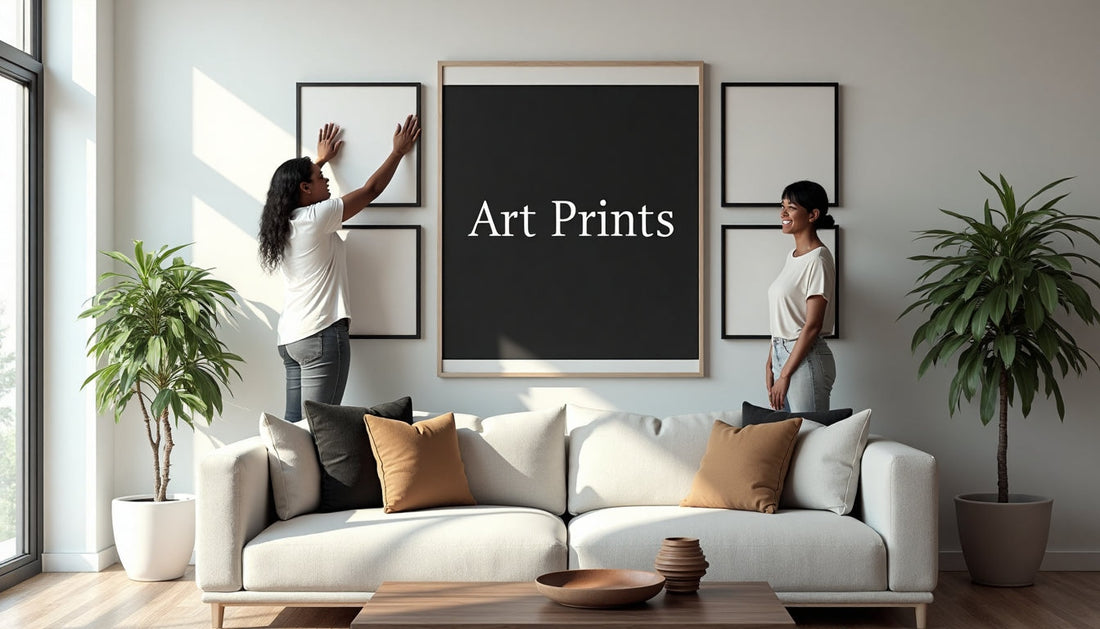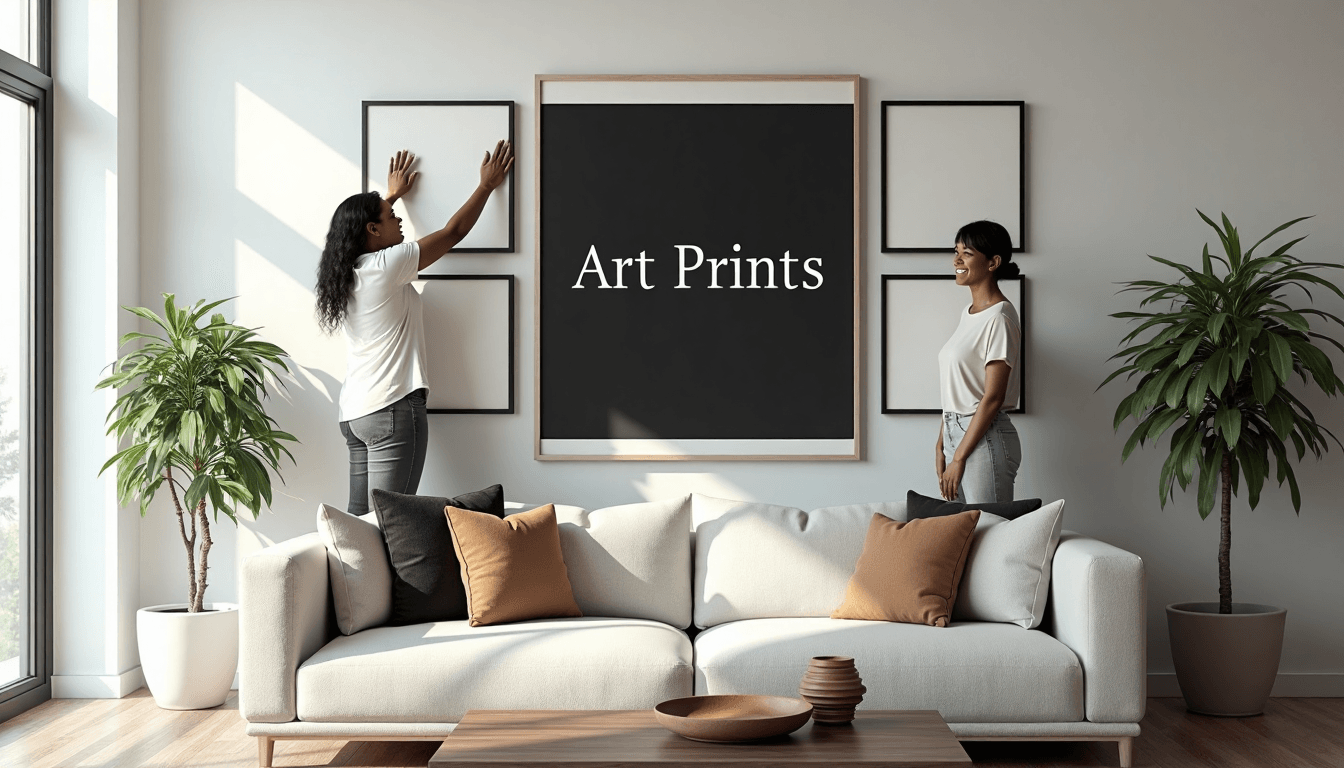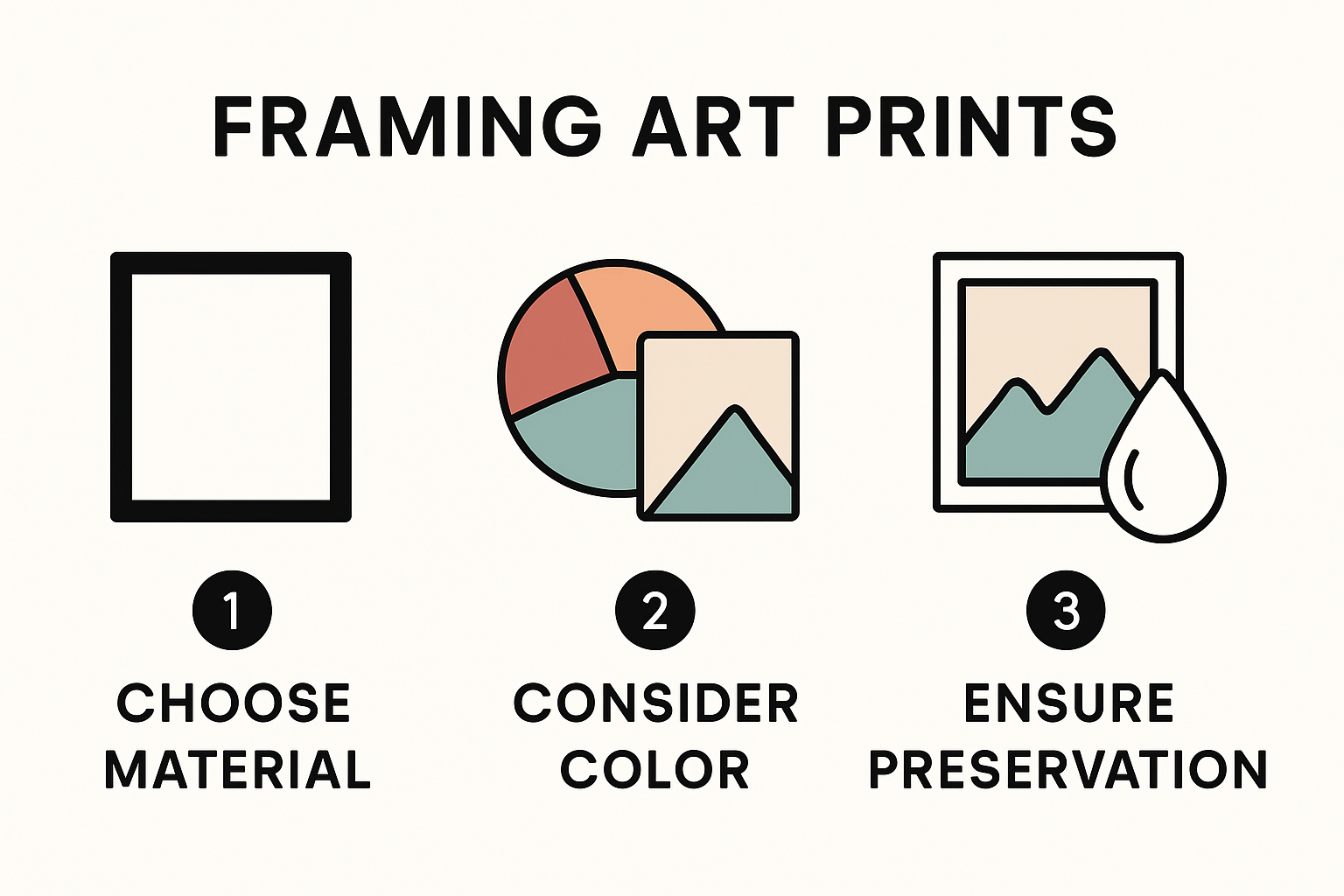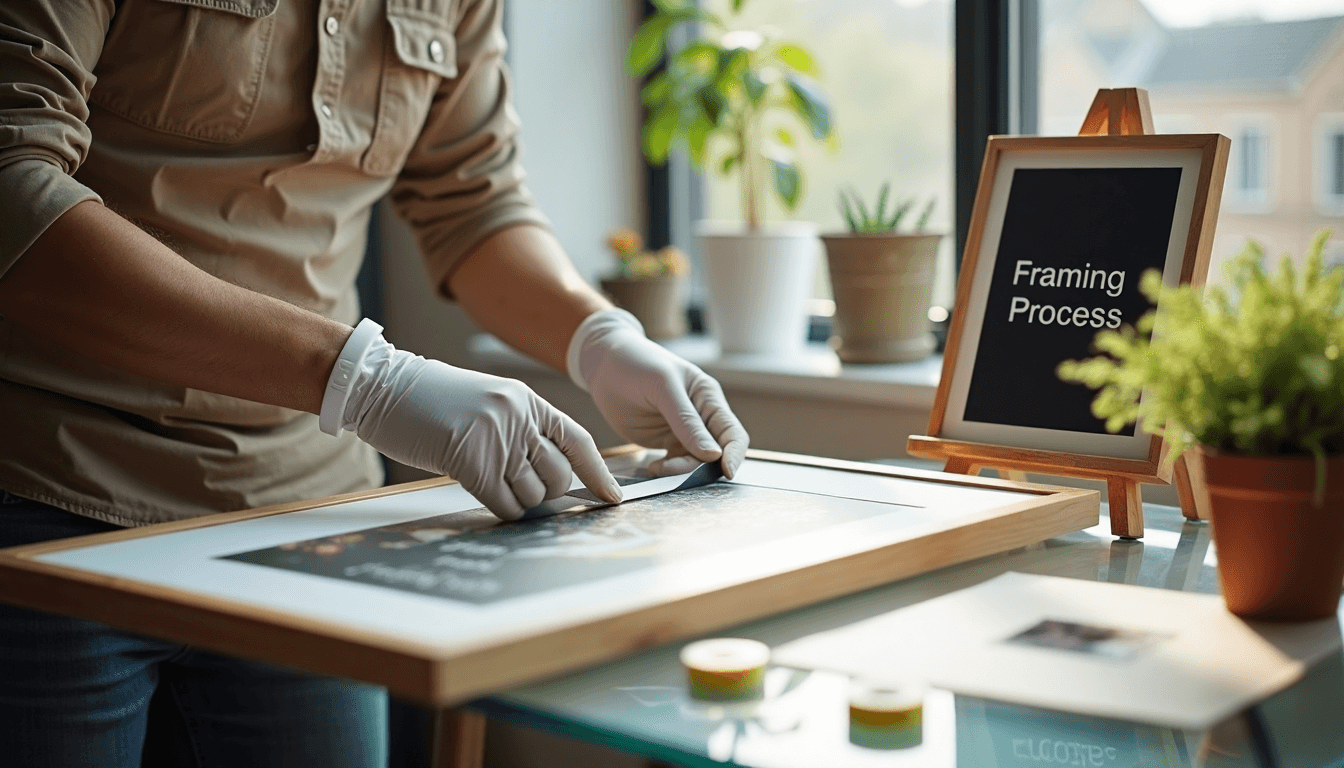
Framing Art Prints Guide 2025: Expert Tips for Modern Decor

Framing art prints is often seen as a finishing touch for your home, but the impact goes much deeper. Here’s something most people miss. Nearly 60 percent of art fading is caused by UV light exposure, not just age or poor materials. This means the right framing choice does more than look good; it quietly safeguards your favorite pieces and transforms your space in surprising ways.
Table of Contents
- Choosing The Right Frame For Your Art Prints
- Step-By-Step Framing Process For Prints And Canvas
- Creative Display Ideas For Modern And Luxury Spaces
- Expert Tips For Preserving And Caring For Art Prints
Quick Summary
| Takeaway | Explanation |
|---|---|
| Choose the Right Frame Material | Select frame materials that match your artwork’s style and origin, such as wooden frames for traditional art and metal for modern pieces. |
| Prioritize Color Coordination | Use frames that harmonize with or contrast against the artwork’s dominant colors, considering the room’s overall color palette for a cohesive look. |
| Ensure Preservation and Protection | Invest in UV-protective glazing and acid-free materials to shield artwork from damage and degradation, maintaining vibrancy and longevity. |
| Maintain a Controlled Environment | Store artwork in stable conditions with temperatures between 60-70°F and humidity around 40-50% to prevent warping and mold. |
| Limit Light Exposure | Use UV-filtering glazing and avoid direct sunlight to protect prints from fading, and consider rotating displayed pieces to minimize light damage. |

Choosing the Right Frame for Your Art Prints
Framing art prints requires thoughtful consideration beyond simple aesthetic choices. The right frame protects your artwork while enhancing its visual impact and complementing your interior design. Understanding the nuanced elements of frame selection will transform your art display from ordinary to extraordinary.
Material and Style Considerations
Selecting the perfect frame material involves more than personal preference. Each material communicates a distinct visual language and provides unique benefits. Wooden frames offer warmth and traditional elegance, working beautifully with classic or rustic decor styles. Metal frames deliver sleek, contemporary lines ideal for modern and minimalist spaces. Explore our curated wall art collections to understand how different frame styles can dramatically alter an artwork’s presentation.
According to artfulprinters.com, professional art framers recommend matching frame materials to the artwork’s origin and style. A watercolor might shine in a delicate, thin wooden frame, while a bold abstract piece could demand a substantial metallic border.
Color Coordination and Visual Balance
Color selection represents a critical aspect of frame selection that can make or break your art’s visual appeal. Professional designers suggest using frames that either harmonize with or purposefully contrast against the artwork’s dominant colors. As cie-elle.com.au recommends, dark paintings benefit from lighter frames, creating visual tension and drawing the viewer’s eye.
Consider the room’s existing color palette when choosing your frame. A frame that subtly echoes other design elements creates a cohesive look. Neutral tones like white, black, or natural wood offer versatility and timeless appeal, ensuring your art remains the focal point.
Preservation and Protection
Beyond aesthetics, framing serves a crucial preservation function. According to artsy.net, investing in high-quality, UV-protective glazing can prevent artwork degradation. Specialized glass or acrylic shields delicate prints from harmful ultraviolet rays, maintaining color vibrancy and preventing fading.
Professional framers recommend using acid-free matting and backing materials to prevent chemical reactions that could damage your art over time. Glass with museum-grade UV protection offers the highest level of preservation, ideal for valuable or sentimental pieces.
Choosing the right frame is an art form itself. By carefully considering material, color, and protective qualities, you transform your art prints from simple wall decorations into stunning design statements that reflect your personal style and protect your cherished artwork.
Here’s a table comparing the main features and benefits of different frame materials mentioned, helping you understand their suitability for various art styles and spaces:
| Frame Material | Visual Style | Best For Artwork Type | Room Style Suitability | Key Protection Features |
|---|---|---|---|---|
| Wood | Warm, traditional elegance | Watercolors, classic pieces | Traditional, rustic | Supports acid-free backing; gentle on paper |
| Metal | Sleek, contemporary lines | Abstract, bold art | Modern, minimalist | Durable; suitable for UV-protective glazing |
| Floating | Creates depth, edge exposure | Canvas prints | Contemporary, luxury | Keeps artwork edges visible, wall separation |
Step-by-Step Framing Process for Prints and Canvas

Framing art prints and canvas requires precision, patience, and a systematic approach. Whether you are a seasoned art collector or a first-time framer, understanding the technical steps ensures your artwork remains protected and visually stunning.
Preparing Your Artwork and Workspace
Before beginning the framing process, create a clean and organized workspace. According to the Canadian Conservation Institute, careful examination of your artwork is crucial before framing. Inspect the print or canvas for any existing damage, ensuring its surface is clean and free from dust or debris.
Gather essential tools including acid-free mounting board, archival tape, protective gloves, measuring tape, and a clean work surface. Learn more about art preservation techniques to understand the importance of using archival-quality materials during the framing process.
Mounting and Securing the Artwork
The mounting process requires meticulous attention to detail. For prints, use archival mounting techniques that prevent damage and allow for future removal if needed. Professional framers recommend hinged mounting, which uses minimal adhesive points to secure the artwork without risking permanent alteration.
For canvas prints, consider whether you want a traditional frame or a modern floating frame approach. Floating frames create an illusion of depth, allowing the entire canvas edge to remain visible. Ensure your mounting method provides adequate support while maintaining the artwork’s structural integrity.
Final Assembly and Protective Glazing
Choosing the right glazing is critical for artwork preservation. As the Canadian Conservation Institute recommends, the frame must be strong enough to support the artwork’s weight while providing protection.
Select UV-protective glass or acrylic that shields your artwork from harmful light radiation. Museum-grade glazing offers the highest level of protection, preventing color fading and maintaining the print’s original vibrancy. When assembling the frame, ensure all components fit precisely, with no gaps that could allow dust or moisture to penetrate.
Professional framers suggest leaving a small space between the artwork and glazing to prevent potential moisture buildup. Use archival tape to create a seal that prevents dust intrusion while maintaining the artwork’s pristine condition.
By following these systematic steps, you transform the framing process from a potentially intimidating task into a careful art form. Each decision protects your cherished artwork, ensuring it remains a beautiful focal point in your space for years to come.
Below is a table summarizing the step-by-step framing process for prints and canvas, outlining each stage and its main actions:
| Step | Main Actions |
|---|---|
| Preparing Artwork & Workspace | Clean workspace, inspect artwork, gather archival-quality tools |
| Mounting and Securing | Use archival tape/hinged mounting for prints, select frame type for canvas |
| Final Assembly & Protective Glazing | Insert UV-protective glass/acrylic, seal frame, leave space between glazing and artwork |
Creative Display Ideas for Modern and Luxury Spaces
Transforming your living spaces with art goes beyond simply hanging prints on walls. Modern and luxury interiors demand innovative approaches that elevate artwork from mere decoration to immersive design statements. Understanding strategic display techniques can dramatically enhance your space’s aesthetic and emotional impact.
Curating Gallery Walls and Dynamic Compositions
Gallery walls represent a sophisticated method of showcasing multiple art pieces with intentional visual harmony. Mixing different frame sizes, orientations, and artistic styles creates a dynamic narrative that captures attention. According to blog.daisie.com, incorporating interactive and textural elements can transform static displays into engaging visual experiences.
When designing gallery walls, consider creating visual rhythms through strategic spacing and alignment. Experiment with asymmetrical arrangements that challenge traditional grid-like displays. Explore our modern art themes to discover curated collections that work brilliantly in complex compositional layouts.
Architectural Integration and Spatial Storytelling
Luxury spaces demand more than traditional hanging techniques. ResearchGate studies highlight the importance of thematic narratives in spatial design. Consider integrating artwork as architectural elements transforming walls into immersive storytelling platforms.
Techniques like built-in niches, floating shelves, and strategically backlit displays can turn artwork into focal points that communicate sophisticated design intent. Floating frames that create depth illusions or art pieces mounted flush with walls provide clean, contemporary presentation methods that resonate with minimalist aesthetic principles.
Technology-Enhanced Art Experiences
Contemporary luxury design increasingly embraces technological integration. According to ResearchGate research, visual art can significantly enhance perceived prestige when thoughtfully presented. Modern display techniques now include augmented reality interfaces, programmable lighting that changes artwork appearance, and digital frames that rotate curated collections.
Consider smart display solutions that allow remote artwork management. Digital frames with WiFi connectivity enable instant collection updates, transforming static displays into dynamic, evolving design elements. Projection mapping technologies can also turn entire walls into adaptable canvases, creating immersive art experiences that change with mood and occasion.
By reimagining art display as an interactive, architectural design element, you elevate your living spaces from mere rooms to curated experiences. Each display technique becomes a deliberate choice that reflects personal style, technological sophistication, and artistic appreciation.
Expert Tips for Preserving and Caring for Art Prints
Preserving art prints requires a strategic approach that goes beyond aesthetic considerations. The longevity of your artwork depends on understanding environmental factors, proper handling techniques, and proactive conservation methods. Professional art conservators emphasize that thoughtful care can protect your investment and maintain the artwork’s original beauty for generations.
Environmental Control and Storage Strategies
Environmental conditions play a critical role in art print preservation. According to blogs.library.duke.edu, maintaining a stable environment is crucial. Aim to keep temperatures between 60-70°F with relative humidity around 40-50%. Extreme temperature fluctuations and high humidity can cause paper to warp, expand, or develop mold.
Learn more about protecting your art collection to understand the nuanced techniques of art preservation. When storing prints not currently on display, use acid-free archival boxes, placing acid-free tissue paper between each piece to prevent sticking or transfer of pigments.
Handling and Material Selection
Professional conservators stress the importance of minimal direct handling. Always wear clean, lint-free cotton gloves when touching art prints to prevent oils and dirt from transferring to the artwork. According to library.illinois.edu, use acid-free and lignin-free materials for storage and framing to prevent chemical reactions that can damage paper-based artworks.
When moving or repositioning prints, support the entire piece. Never touch the image area, and avoid folding or creasing. If transportation is necessary, use rigid, acid-free portfolio cases that provide protection from physical damage and environmental fluctuations.
Light Exposure and Protective Measures
Light represents one of the most significant threats to art print preservation. conservation-design.com recommends using UV-filtering glazing and strictly limiting direct sunlight exposure. Prolonged UV radiation can cause irreversible fading and degradation of pigments.
Consider rotating displayed artwork periodically to minimize continuous light exposure. Use museum-grade glass or acrylic with UV protection when framing. Position artwork away from direct sunlight, heat sources, and areas with significant temperature variations. Indirect, controlled lighting helps showcase your prints while minimizing potential damage.
By implementing these expert preservation techniques, you transform art print care from a reactive process to a proactive strategy. Each careful decision contributes to maintaining the artwork’s integrity, ensuring that your cherished pieces remain vibrant and meaningful for years to come.
Frequently Asked Questions
What materials are best for framing art prints?
Choosing the right frame material depends on the style of your artwork. Wooden frames work well with traditional pieces, while metal frames suit modern art. For preservation, opt for materials with UV protection and acid-free backing.
How can I protect my art prints from UV light?
To protect your art prints from UV light, use UV-filtering glass or acrylic when framing. Additionally, avoid direct sunlight exposure and consider rotating displayed pieces periodically to minimize light damage.
What is the proper way to mount art prints?
For mounting art prints, use archival techniques such as hinged mounting with minimal adhesive. This allows for future removal without damaging the artwork. Ensure the mounting provides adequate support to maintain the print’s integrity.
How should I care for and preserve my framed art prints?
Maintain your framed art prints by controlling environmental conditions, handling them with care, and limiting light exposure. Store prints in a stable environment, ideally between 60-70°F with humidity levels around 40-50%. Use acid-free materials for storage and framing.
Elevate Your Space With Lasting Art and Flawless Framing
If you’ve ever struggled to find that perfect art print — one that not only looks beautiful but endures for years — you already know how frustrating it can be when colors fade or cheap frames damage your investment. This guide points out exactly what you might be missing: premium protection, color harmony, and care that keeps your decor vibrant. Marta Ellie understands how important it is to both showcase art and preserve its value, whether you love abstract statements or thoughtful portraiture.

Ready to see how expert framing can transform your home and keep your collection safe? Discover Marta Ellie’s canvas prints and curated collections featuring archival-quality materials and eye-catching designs. Experience art that’s crafted to stay beautiful and add meaning to every corner of your home. Shop modern wall art now and choose pieces you will be proud to display for years. Visit Marta Ellie’s website to start your collection and secure lasting beauty for your space today.
Recommended
- How to Choose Art for Living Room Walls: 2025 Guide – Exclusive Canvas Art
- Living Room Wall Art Trends 2025: Modern Canvas and Print Ideas – Exclusive Canvas Art
- Caring for Canvas Art: Expert Tips for Wall Decor 2025 – Exclusive Canvas Art
- How to Display Canvas Prints: Fresh Ideas for Modern Walls 2025 – Exclusive Canvas Art
- Storytelling Through Art: Wall Decor Ideas for 2025 Collectors – Exclusive Canvas Art
- How to Store Canvas: Protect Modern Art & Luxury Prints 2025 – Exclusive Canvas Art